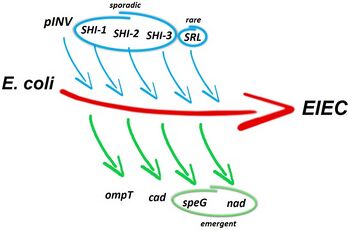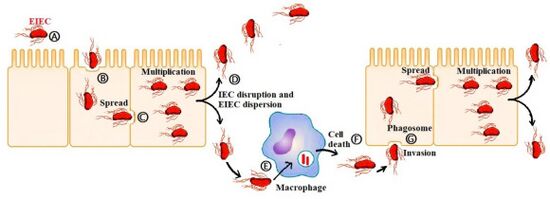Enteroinvasive Escherichia coli
| Enteroinvasive Escherichia coli | |
|---|---|
 | |
| Genetic events contributing to the evolution of EIEC from ancestral commensal E. coli. The acquisition of the pINV by HGT is a major evolutionary event toward pathogenicity[1] | |
Enteroinvasive Escherichia coli (EIEC) is a type of pathogenic bacteria whose infection causes a syndrome that is identical to shigellosis, with profuse diarrhea and high fever. EIEC are highly invasive, and they use adhesin proteins to bind to and enter intestinal cells. They produce no toxins, but severely damage the intestinal wall through mechanical cell destruction.
EIEC are closely related to Shigella, like all E. coli are.[2][3] Their similarity in disease phenotype come from a homologous large virulence plasmid pINV. They also have in common in their loss of cadaverine synthesis, of ompT, and of curli formation. These features are probably acquired independently, as the two lost cadaverine synthesis in different ways.[4] Moreover, the "EIEC" does not form a monophyletic group in E. coli.[1]
After the E. coli strain penetrates through the epithelial wall, the endocytosis vacuole gets lysed, the strain multiplies using the host cell machinery, and extends to the adjacent epithelial cell. In addition, the plasmid of the strain carries genes for a type III secretion system that is used as the virulent factor. Although it is an invasive disease, the invasion usually does not pass the submucosal layer. The similar pathology to shigellosis may be because both strains of bacteria share some virulent factors. The invasion of the cells can trigger a mild form of diarrhea or dysentery, often mistaken for dysentery caused by Shigella species. The illness is characterized by the appearance of blood and mucus in the stools of infected individuals or a condition called colitis.[citation needed]
Dysentery caused by EIEC usually occurs within 12 to 72 hours following the ingestion of contaminated food. The illness is characterized by abdominal cramps, diarrhea, vomiting, fever, chills, and a generalized malaise. Dysentery caused by this organism is generally self-limiting with no known complications.[5]
It is currently unknown what foods may harbor EIEC, but any food contaminated with human feces from an ill individual, either directly or via contaminated water, could cause disease in others. Outbreaks have been associated with hamburger meat and unpasteurized milk.[6]
Enterovirulent classes of E. coli are referred to as the EEC group (enterovirulent E. coli):[citation needed]
- Enteroinvasive E. coli (EIEC) invades (passes into) the intestinal wall to produce severe diarrhea.
- Enterohemorrhagic E. coli (EHEC): A type of EHEC, E. coli O157:H7, can cause bloody diarrhea and hemolytic uremic syndrome (anemia and kidney failure).
- Enterotoxigenic E. coli (ETEC) produces a toxin that acts on the intestinal lining, and is the most common cause of traveler's diarrhea.
- Enteropathogenic E. coli (EPEC) can cause diarrhea outbreaks in newborn nurseries.
- Enteroaggregative E. coli (EAggEC) can cause acute and chronic (long-lasting) diarrhea in children.

See also
References
- ↑ 1.0 1.1 Pasqua, Martina; Michelacci, Valeria; Di Martino, Maria Letizia; Tozzoli, Rosangela; Grossi, Milena; Colonna, Bianca; Morabito, Stefano; Prosseda, Gianni (2017). "The Intriguing Evolutionary Journey of Enteroinvasive E. coli (EIEC) toward Pathogenicity". Frontiers in Microbiology. 8: 2390. doi:10.3389/fmicb.2017.02390. ISSN 1664-302X. Archived from the original on 2023-01-19. Retrieved 2023-04-24.
- ↑ Lan R, Alles MC, Donohoe K, Martinez MB, Reeves PR (September 2004). "Molecular evolutionary relationships of enteroinvasive Escherichia coli and Shigella spp". Infect. Immun. 72 (9): 5080–8. doi:10.1128/IAI.72.9.5080-5088.2004. PMC 517479. PMID 15322001.
- ↑ Rolland K, Lambert-Zechovsky N, Picard B, Denamur E (September 1998). "Shigella and enteroinvasive Escherichia coli strains are derived from distinct ancestral strains of E. coli". Microbiology. 144 (9): 2667–72. doi:10.1099/00221287-144-9-2667. PMID 9782516.
- ↑ "Shigella". Bergey's Manual of Systematics of Archaea and Bacteria. 17 April 2015. doi:10.1002/9781118960608.gbm01168.
- ↑ "Bad Bug Book: Handbook of Foodborne Pathogenic Microorganisms and Natural Toxins (PDF)" (PDF). Food and Drug Administration. Archived (PDF) from the original on April 18, 2013. Retrieved June 8, 2015.
- ↑ Escherichia coli, enteroinvasive Material Data Safety Sheets
- ↑ Govindarajan, Deenadayalan Karaiyagowder; Viswalingam, Nandhini; Meganathan, Yogesan; Kandaswamy, Kumaravel (1 September 2020). "Adherence patterns of Escherichia coli in the intestine and its role in pathogenesis". Medicine in Microecology. 5: 100025. doi:10.1016/j.medmic.2020.100025. ISSN 2590-0978.
External links
| Classification |
|---|